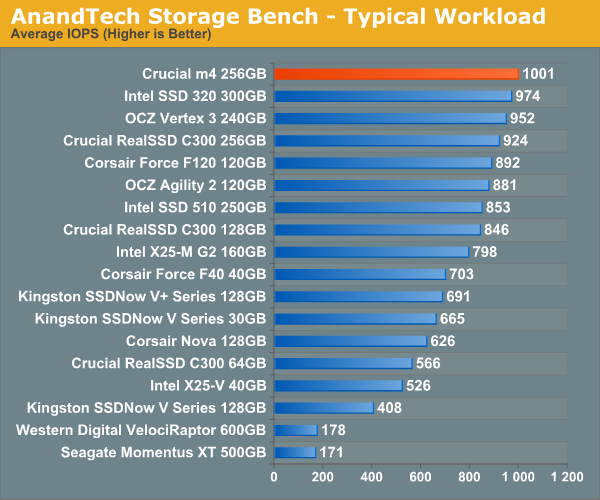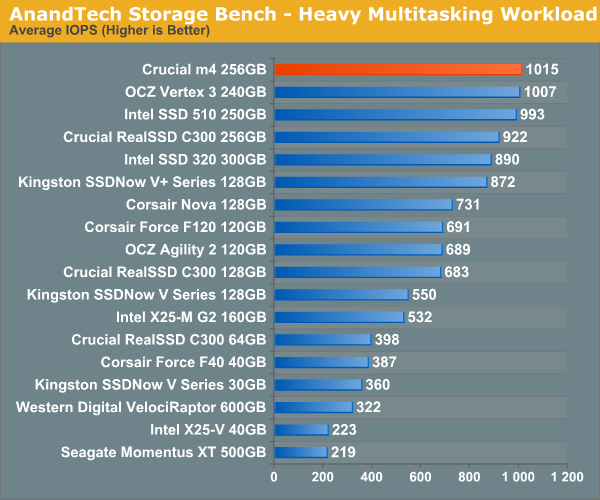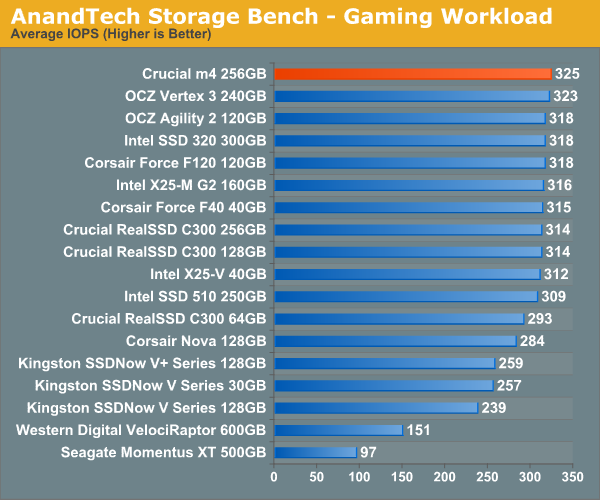The Crucial m4 (Micron C400) SSD Review
by Anand Lal Shimpi on March 31, 2011 3:16 AM ESTAnandTech Storage Bench 2010
To keep things consistent we've also included our older Storage Bench. Note that the old storage test system doesn't have a SATA 6Gbps controller, so we only have 3Gbps results for the 6Gbps drives.
The first in our benchmark suite is a light/typical usage case. The Windows 7 system is loaded with Firefox, Office 2007 and Adobe Reader among other applications. With Firefox we browse web pages like Facebook, AnandTech, Digg and other sites. Outlook is also running and we use it to check emails, create and send a message with a PDF attachment. Adobe Reader is used to view some PDFs. Excel 2007 is used to create a spreadsheet, graphs and save the document. The same goes for Word 2007. We open and step through a presentation in PowerPoint 2007 received as an email attachment before saving it to the desktop. Finally we watch a bit of a Firefly episode in Windows Media Player 11.
There’s some level of multitasking going on here but it’s not unreasonable by any means. Generally the application tasks proceed linearly, with the exception of things like web browsing which may happen in between one of the other tasks.
The recording is played back on all of our drives here today. Remember that we’re isolating disk performance, all we’re doing is playing back every single disk access that happened in that ~5 minute period of usage. The light workload is composed of 37,501 reads and 20,268 writes. Over 30% of the IOs are 4KB, 11% are 16KB, 22% are 32KB and approximately 13% are 64KB in size. Less than 30% of the operations are absolutely sequential in nature. Average queue depth is 6.09 IOs.
The performance results are reported in average I/O Operations per Second (IOPS):

Lighter read-heavy workloads do very well on the m4. Thankfully for Crucial, most user workloads tend to be very read intensive. Over a 3Gbps interface, the m4 is a bit faster than Intel's 320 in our typical workload from 2010.
If there’s a light usage case there’s bound to be a heavy one. In this test we have Microsoft Security Essentials running in the background with real time virus scanning enabled. We also perform a quick scan in the middle of the test. Firefox, Outlook, Excel, Word and Powerpoint are all used the same as they were in the light test. We add Photoshop CS4 to the mix, opening a bunch of 12MP images, editing them, then saving them as highly compressed JPGs for web publishing. Windows 7’s picture viewer is used to view a bunch of pictures on the hard drive. We use 7-zip to create and extract .7z archives. Downloading is also prominently featured in our heavy test; we download large files from the Internet during portions of the benchmark, as well as use uTorrent to grab a couple of torrents. Some of the applications in use are installed during the benchmark, Windows updates are also installed. Towards the end of the test we launch World of Warcraft, play for a few minutes, then delete the folder. This test also takes into account all of the disk accesses that happen while the OS is booting.
The benchmark is 22 minutes long and it consists of 128,895 read operations and 72,411 write operations. Roughly 44% of all IOs were sequential. Approximately 30% of all accesses were 4KB in size, 12% were 16KB in size, 14% were 32KB and 20% were 64KB. Average queue depth was 3.59.

Last year's heavy multitasking workload was also predominantly read heavy. The m4 does very well here again, roughly equaling the performance of OCZ's Vertex 3.
The gaming workload is made up of 75,206 read operations and only 4,592 write operations. Only 20% of the accesses are 4KB in size, nearly 40% are 64KB and 20% are 32KB. A whopping 69% of the IOs are sequential, meaning this is predominantly a sequential read benchmark. The average queue depth is 7.76 IOs.

Gaming performance is good but we're of course bottlenecked by the 3Gbps SATA interface in this test.










103 Comments
View All Comments
killless - Friday, April 1, 2011 - link
I frequently use VMWare at work.One of the tasks that takes forever is deleting VMWare snapshots. Or even worse one is shrinking VMWare disk foot print. In both of these cases 95% is spent on disk read/write. They take from minutes to hours. They mix random and sequential access.
More that that they are fairly repeatable...
Using Kingstone SSDNow instead of harddisk made a huge impact - it is about 3 times faster. However it still takes 2 hours sometimes to shrink disk.
I think that would be a good repeatable set of tests.
CrustyJuggler - Saturday, April 2, 2011 - link
I just bought a spanking 15" MacBook Pro which i know supports Intels new Sandybridge and the sata6gb interface. I decided to buy with just the stock HDD which i will move to the optical bay after purchasing one of these new spangly SSDsAfter reading just about every review i'm still non the wiser as to which drive would benefit me the most so I think in conclusion i will wait for the leading drives to be released. The OCZ is always favourable in the benchmarks but the horror stories of reliability coupled with dreadful customer support make me nervous.
The intel 510 seems to have great support and reliability but poor performance.
I've heard little to nothing about Corsair's ForceGT which should be somewhere in the realms Vertex 3 performance right?
I'm happy to wait at least another 8 weeks i think and just hope more reviews and testing shows up in that time.. I was using a Force F60 on the laptop i replaced and I had no problems whatsoever so i hope Corsair can have a timely release with the GT.
I had my eye on Crucial's M4 for a while now but these latest crop of reviews have left me pondering even more. Trim is not supported on Mac as of yet so Anand's take on the M4 makes alarm bells ring regarding trim
First time poster long time reader, but not very tech savvy so what do to folks?
Shark321 - Sunday, April 3, 2011 - link
Anand is #1 at SSD reviews, but there still a long way to achieve perfection.On many workstations in my company we have a daily SSD usage of at least 20 GB, and this is not something really exceptional.
One hibernation in the evening writes 8 GB (the amount of RAM) to the SSDs. And no, Windows does not write only the used RAM, but the whole 8 GB. One of the features of Windows 8 will be that Windows does not write the whole RAM content when hibernating anymore. Windows 7 disables hibernation by default on system with >4GB of RAM for that very reason!
Several of the workstation use RAM-Disks, which write a 2 or 3 GB Images on Shutdown/Hibernate.
Since we use VMWare heavily, 1-2 GB is written contanstly all over the day as Spanshots. Add some backup spanshops of Visual Studio products to that and you have another 2 GB.
Writing 20 GB a day, is nothing unusual, and this happens on at least 30 workstations. Some may even go to 30-40 GB.
From all the SSDs we have used over the years, there was about 10% failure rate within 2 years, so daily backups are really necessary. When doing a backup of a SSD to a HDD with True Image, the performance of the individual SSDs differs a lot.
So future benchmarks for professional users should take into consideration:
- a daily usage of at least 20 GB (better 40 GB)
- benchmarking VMWare creating snapshots and shringing images
- unpacking of large ISO images
- hibernate peformance
- backup performance
Thanks!
789427 - Monday, April 4, 2011 - link
Anand, can't you design a power measurement benchmark whereby typical disc activity is replicated.e.g. Power consumption while video encoding (the time taken shouldn't vary by more than 10% - you could add in the difference in idle power consumption as well!
Or... copying 100 different 1 Mb sections at 1 sec intervals of a 20 min media file - Mp3, divx mkv
My point is that Sure, SSD's make your system use more power in most benchmarks because the system is asked to do more. Ask the system to do the same thing over the same period and measure power consumption.
cb
gunslinger690 - Tuesday, April 5, 2011 - link
Ok all I really care about on the machine I'm considering using this on is gaming and web surfing. That's all I care about. Is this a good drive for this sort of app.VJ - Thursday, April 7, 2011 - link
"I've already established that 3000 cycles is more than enough for a desktop workload with a reasonably smart controller."You haven't "established" much unless you take the free space into consideration. Many desktop users will not have 100GB free space on their drives and with 20GB free space and a write amplification of 10x, the lifetime of a drive may drop to a couple of years.
A 3D plot of the expected lifetime as a function of available free space (10GB-100GB) and write amplification (1x-20x) would make your argument more sound and complete.
Hrel - Saturday, April 16, 2011 - link
I'd really like to know if using a SSD actually has any real world impact. I mean, benchmarks are great. But come on, it's not gonna make me browse the internet any fast or get me higher FPS in Mass Effect; so what's the point? Really, the question comes down to why should I go out and buy two 2TB hard drives, RAID them then ALSO buy an SSD to install the OS on? So windows boots in 7 seconds instead of 27? Cause quite frankly if it's gonna cost me an extra 120-240 dollars I'll just wait 20 seconds. I almost never boot my machine from scratch anyway.Ideally I'd want to use a machine with an SSD in it before buying one. But since that doesn't seem likely I'd love it if you guys could just point a camera at two machines right next to eachother, boot them up, wait for both to finish loading the OS. Then use them. Go online, read some anandtech, boot up Word and type something, open photoshop and edit a picture then start up a game and play for a couple minutes. Cause I'm willing to bet, with the exception of load times, there will be no difference at all. And like I already said, if my game takes 20 seconds to load instead of 5, I can live with that. It's not worth anywhere near 100+ dollars.
Just to be clear one should have an SSD in it near to the 100 dollar mark, since that's as expensive of an SSD most people can even afford to consider. And the other should have two modern 7200rpm mechanical disks from WD in a striped RAID.
Hrel - Saturday, April 16, 2011 - link
both on 6GBPS on P67.Hrel - Saturday, April 16, 2011 - link
forgot to mention, the SSD machine should also have the same 2 mechanical disks in striped RAID and all the games and programs should be installed on those. Cause for 100 dollars the only thing you can put on an SSD is the OS and some small programs like the browser and various other things every PC needs to be usable; maybe photoshop too but the photos couldn't be on the SSD.Hrel - Saturday, April 16, 2011 - link
the games can't be installed on the SSD is my point.